|
Messerschmitt Bf 109 G-2
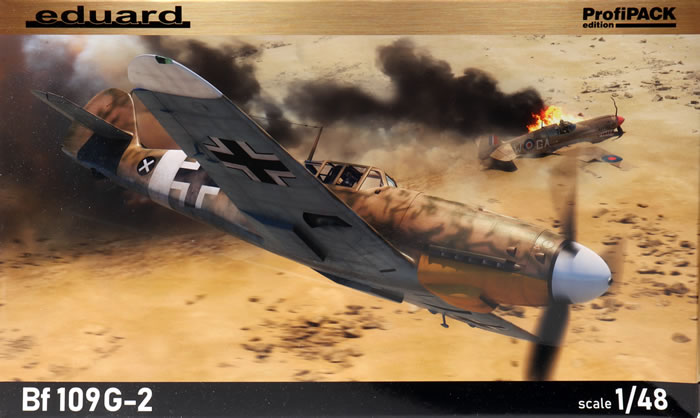
Eduard ProfiPACK, 1/48 scale
S
u m m a r y |
| Catalogue Number: |
Eduard Kit No. 82165 - Messerschmitt Bf 109 G-2 ProfiPACK |
| Scale: |
1/48 |
| Contents and Media: |
186 parts in grey coloured plastic (including 98 marked not for use); 14 parts in clear (8 not used); colour photo-etched fret; self-adhesive die-cut masking sheet; markings for five aircraft |
| Price: |
USD$49.95 plus shipping,
available online now from Eduard
GBP£28.65 (£23.88 Export Price) plus shipping available from Hannants |
| Review Type: |
FirstLook |
| Advantages: |
Accurate; high level of detail; outstanding surface features including crisply recessed panels and subtle rivet lines where appropriate; includes colour photo-etched parts; separate control surfaces; many useful options including alterative propeller blades, wheels, oil cooler housings, bomb racks, trop filter and supercharger intakes (some parts not applicable for this kit); includes die-cut canopy masks. |
| Disadvantages: |
Toothy exhaust stacks. |
| Conclusion: |
Eduard's 1/48 scale Bf 109 G-2 kit is well detailed and boasts surface textures as good as anything currently available. The addition of coloured photo-etched parts plus an excellent decal sheet with six varied options is a real bonus.
I have already built at least four of Eduard's 1/48 scale Bf 109 G kits and they were all a joy to work on - straightforward engineering, brilliant fit and a gorgeous result once they're finished. I have no reason to expect that this kit will be any different.
Highly Recommended. |
Reviewed by Brett Green

The Bf 109 G-series was developed from the largely identical F-series airframe, although there were detail differences. Modifications included a reinforced wing structure, an internal bullet-proof windscreen, the use of heavier, welded framing for the cockpit transparencies, and additional light-alloy armour for the fuel tank. It was originally intended that the wheel wells would incorporate small doors to cover the outer portion of the wheels when retracted. To incorporate these the outer wheel bays were squared off. Two small inlet scoops for additional cooling of the spark plugs were added on both sides of the forward engine cowlings. A less obvious difference was the omission of the boundary layer bypass outlets, which had been a feature of the F-series, on the upper radiator flaps.
Like most German aircraft produced in World War II, the Bf 109 G-series was designed to adapt to different operational tasks with greater versatility; larger modifications to fulfil a specific mission task, such as long-range reconnaissance or long-range fighter-bomber, were with "Rüststand" and given a "/R" suffix, smaller modifications on the production line or during overhaul, such as equipment changes, were made with kits of pre-packaged parts known as Umrüst-Bausätze, usually contracted to Umbau and given a "/U" suffix. Field kits known as Rüstsätze were also available but those did not change the aircraft designation. Special high-altitude interceptors with GM-1 nitrous oxide injection high-altitude boost and pressurized cockpits were also produced.
The newly fitted Daimler-Benz DB 605A engine was a development of the DB 601E engine utilised by the preceding Bf 109 F-4; displacement and compression ratio were increased as well as other detail improvements to ease large-scale mass production. Takeoff and emergency power of 1,475 PS (1,455 hp, 1,085 kW) was achieved with 1.42 atm (42.5 inches/6.17 lbs) of boost at 2,800 rpm. The DB 605 suffered from reliability problems during the first year of operation, and this output was initially banned by VT-Anw.Nr.2206, forcing Luftwaffe units to limit maximum power output to 1,310 PS (1,292 hp, 964 kW) at 2,600 rpm and 1.3 atm manifold pressure (38.9 inches/4.4 lbs). The full output was not reinstated until 8 June 1943 when Daimler-Benz issued a technical directive. Up to 1944, the G-series was powered by the 1,475 PS Daimler-Benz DB 605 driving a three-blade VDM 9-12087A variable-pitch propeller with a diameter of 3 m (9.8 ft) with even broader blades than used on the F-series. Pitch control, as on the 109F, was either electro-mechanical (automatic) or manual-electric using a thumb-switch on the throttle lever.[61] From 1944 a new high-altitude propeller with broader blades was introduced, designated VDM 9-12159, and was fitted to high-altitude variants with the DB 605AS or D-series engines.
The early versions of the Bf 109G closely resembled the Bf 109 F-4 and carried the same basic armament; however, as the basic airframe was modified to keep pace with different operational requirements, the basically clean design began to change.
Bf 109 G-1 and G-2
The G-1, produced from February 1942, was the first production version of the G-series and the first production Bf 109 with a pressurized cockpit. It could be identified by the small, horn-shaped air intake for the cockpit compressor just above the supercharger intake, on the left upper cowling. In addition, the angled armour plate for the pilot's head was replaced by a vertical piece which sealed-off the rear of the side-hinged cockpit canopy. Small, triangular armour-glass panels were fitted into the upper corners of this armour, although there were aircraft in which the plate was solid steel. Silica gel capsules were placed in each pane of the windscreen and opening canopy to absorb any moisture which may have been trapped in the double glazing. The last 80 G-1s built were lightweight G-1/R2. In these GM-1 nitrous oxide 'boost' was used, and the pilot's back armour was removed, as were all fittings for the long-range drop tank. A few G-1 flown by I./JG 1 are known to have carried the underwing 20 mm MG 151/20 cannon gondolas.

The Bf 109 G-2, which started production in May 1942, lacked the cabin pressurization and GM-1 installation. Performance-wise it was identical to the G-1. The canopy reverted to one layer of glazing and incorporated the angled head armour used on the F-4, although several G-2 had the vertical type as fitted to the G-1. Several Rüstsätze could be fitted, although installing these did not change the designation of the aircraft. Instead the "/R" suffix referred to the G-2's Rüstzustand or equipment condition of the airframe, which was assigned at the factory rather than in the field. There were two Rüstzustand[citation needed] planned for G-2s:
-
G-2/R1: Long-range fighter-bomber. It carried a bomb up to 500 kg (1,100 lb) under the fuselage and had a modified fuel system with underwing fittings for a 300 L (80 US gal) drop tank. As a standard Bf 109G had not enough ground clearance to carry a 500 kg bomb, a jettisonable auxiliary undercarriage was added just aft of the cockpit. The prototype was the FiSk 199. No production known
-
G-2/R2: a reconnaissance aircraft with GM-1 and camera equipment. The rack and internal fuel lines for carrying a 300 L (80 US gal) under-fuselage drop-tank were widely used on G-2s, as were the underwing 20 mm MG 151/20 cannon gondolas. Several G-2s were fitted with the ETC 500 bomb rack, capable of carrying one 250 kg (550 lb) bomb. The final G-2 production batches built by Erla and Messerschmitt Regensburg were equipped as tropical aircraft (often referred to as G-2 trop), equipped with a sand-filter on the front of the supercharger intake and two small, teardrop-shaped metal brackets on the left side of the fuselage, below the cockpit sill. These were used as mounts for specially designed sun umbrellas (called Sonderwerkzeug or Special tool), which were used to shade the cockpit.
A total of 167 G-1s were built between February and June 1942,[67] 1,586 G-2s between May 1942 and February 1943, and one further G-2 was built in Gy?r, Hungary, in 1943. Maximum speed of the G-2 was 537 km/h (334 mph) at sea level and 660 km/h (410 mph) at 7,000 m (22,970 ft) rated altitude with the initial reduced 1.3 atm rating. Performance of the G-1 was similar, but above rated altitude the GM-1 system it was equipped with could be used to provide an additional 350 horsepower.[69] With his G-1/R2, pilot R. Klein achieved 660 km/h (420 mph) at 12,000 m (39,370 ft), and a ceiling of 13,800 m (45,275 ft).
The following variants of the G-1 and G-2 were produced:
-
G-0 (Pre-production aircraft, powered by a DB 601E engine)
-
G-1 (Pressurized fighter, powered by a DB 605A engine)
-
G-1/R2 (Reconnaissance fighter)
-
G-1/U2 (High-altitude fighter with GM-1)
-
G-2 (Light fighter)
-
G-2/R1 (Long-range Fighter-bomber or JaboRei, with 2 × 300 L/80 US gal underwing drop tanks, 500 kg/1,100 lb bomb under fuselage, extended second tail wheel, only prototype)
-
G-2/R2 (Reconnaissance fighter)
- G-2 trop (Tropicalized fighter) *
* Historical summary courtesy of Wikipedia
Eduard originally released their 1/48 scale Messerschmitt Bf 109 G-2 in early 2017. Eduard had previously offered a Messerschmitt Bf 109 G-2 in their 2014 Royal Class Bf 109 G release, but 2017 was the first time that we saw the Bf 109 G-2 as a standalone kit.
Also note that the 2014 Royal Class kit was the original tooling, whereas this G-2 is based on the new and improved tooling that appeared in 2016.
This is essentially a re-boxing of the 2021 release.
Let's take a look at this one in detail.
Eduard's 1/48 scale Bf 109 G-2 ProfiPACK comprises 186 parts in grey plastic, although there are 98 marked "not for use", bringing the total actually used to 88. There are also 14 parts in clear (8 not used), a coloured photo-etched fret, a brass photo-etched fret, self-adhesive canopy masks and markings for six aircraft.
The fuselage is presented as a full-length side per half, including the fin moulded in place, so there should not be any dramas with aligning multiple parts. The upper cowl is moulded to each fuselage half too, with inserts provided for the gun troughs.
In 2013, Eduard’s Spitfire family set a new benchmark for 1/48 scale surface detail, and this Bf 109 G-2 is equally impressive in this regard. Panel lines are very crisp, fine and even. Lines of rivets are present, but they are very subtle.
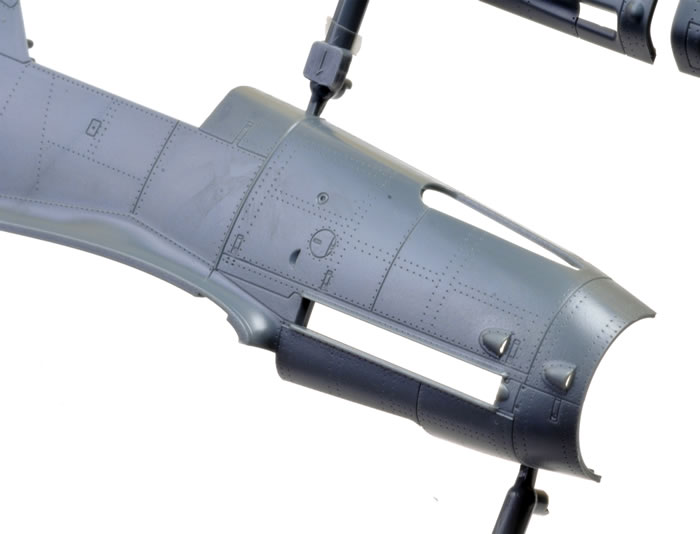
Fabric matches this high standard, with strip and stitching texture beautifully presented on the control surfaces. If you look closely enough, you will even see the zig-zag pinking edges on the fabric strips.
The revised photo-etched cockpit parts include a nice multi-layered instrument panel with glossy lenses, harness straps and other coloured details. Half-tones and shading look great on Eduard's latest photo-etched frets, especially the harness straps. Exterior parts are also included on the sole fret. These include radiator and oil cooler faces, Morane mast, exhaust flame damper and more.

The cockpit is fitted with the G-style pan seat
The canopy is offered in three pieces with the windscreen, fixed rear section and poseable centre. The inclusion of the clear fuel line is a welcome touch. The inspection tube may be masked so that it remains clear after painting.
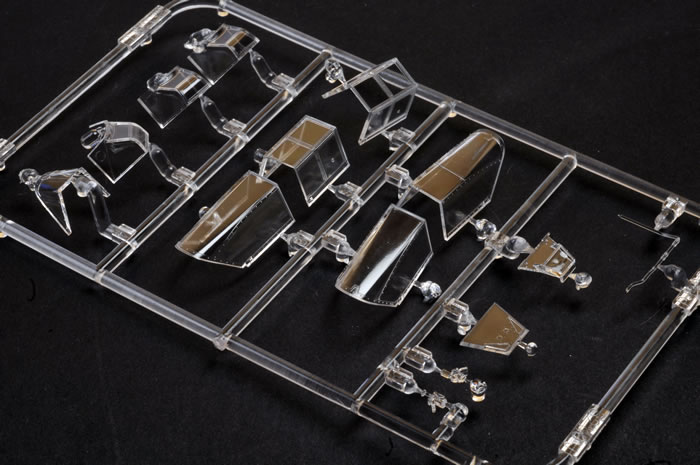
The circular wheel wells are nicely detailed. Eduard depicts the wheel well sidewalls with the zippered canvas covers at the front and rear. The fabric texture looks good, and the zipper is represented by a raised line.
The exhausts are supplied in one piece for each side with an optional moulded-on shroud. The centreline weld beads are present, and each of the stacks are hollowed out at the end.
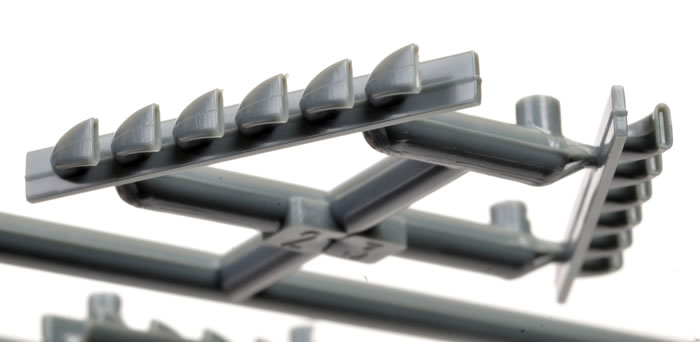
Three propeller assembly options are supplied with nice pitch collar and hub detail.
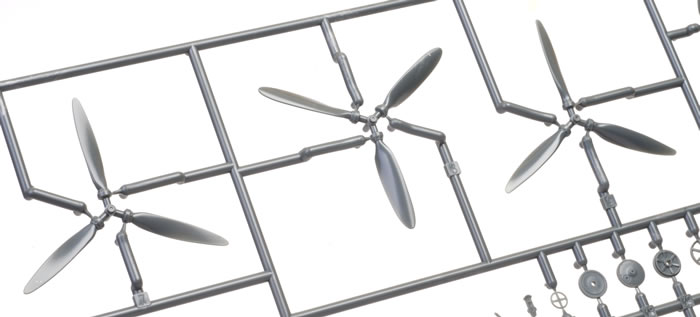
Two styles apply to earlier versions, while the third is appropriate for the Bf 109 G-2.
Engineering and Options
The model may be built as a standard G-2, or a G-2/Trop, or an R6 gunboat.
Other options are also available on the sprues although not necessarily mentioned in the instructions.
The kit is broken down conventionally. The fuselage is full-length with no structural inserts. The two deep pressed gun troughs are separate parts.
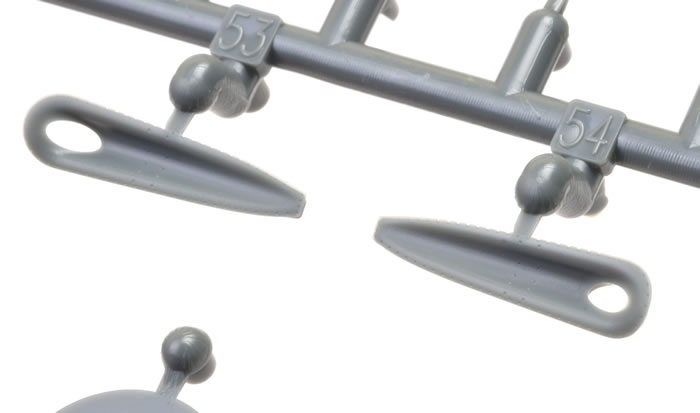
The upper and lower cowls are moulded as part of the fuselage sides.
The initial release supplied two full sets of wings - one with the wheel bulges on the upper wings and one without. This time around, we are only offered the non-bulged wipper wing halves.
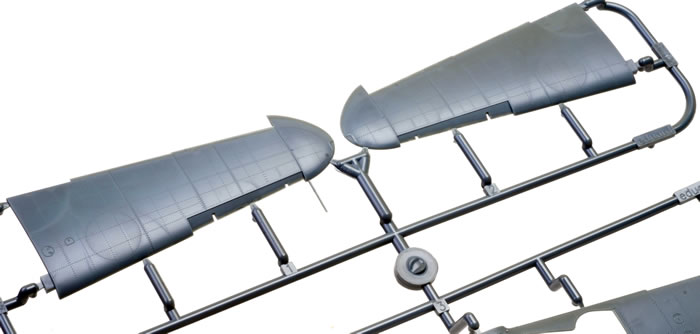
There are a quite a number of options on the sprues that apply to earlier or later versions, so pay attention to the instructions.
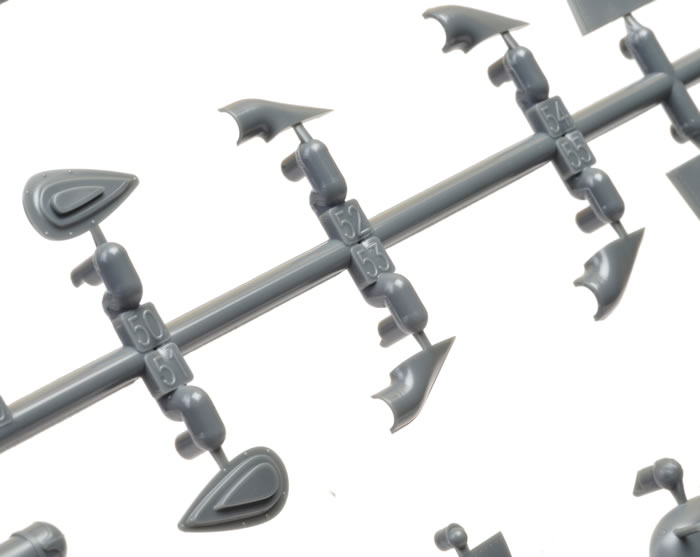
Your spares box will enjoy a boost!
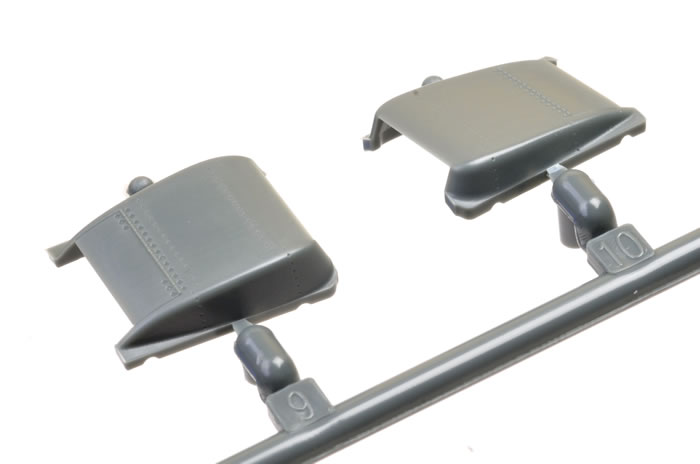
The wing tips are moulded as part of the upper wing halves with solid navigation lights and the pitot tube moulded in place.
All control surfaces are separate, including leading edge slats, ailerons, flaps, elevators and rudder. The ramps at the leading edges of the radiator housings and the cooling flaps at the back of the oil coolers are moulded shut. All the radiator faces are supplied as photo-etched parts.
Many options are offered on the sprues including a drop tank, bombs, bomb racks and different styles of wheel hubs. Some of these relate to earlier and later Bf 109 G or F versions and do not apply, but others – even though they are marked “not for use” – might come in handy for the enterprising modeller.
Check your references to see which of these features is present on your preferred subject – a number of different combinations are possible.
Markings
Markings are supplied for five varied Messerschmitt Bf 109 G-2s.
-
Bf 109 G-2/trop, 2./ JG 77, Matmata, Tunisia, early 1943. Finished in desert colours of RLM 78 and 79 with a squiggly green pattern over the upper surfaces.
-
Bf 109 G-2/R-6/trop, W. Nr. 13916, Fw. Hans Döbrich, 6./ JG 5, Alakurtti, Finland, February 1943with winter whitewash.
-
Bf 109 G-2/R6, Lt. Walter Krupinski, 6./ JG 52, Maykop, Soviet Union, October 1942 in classic mid-war greys, RLM 74, 75, 76, and yellow Eastern Front theatre markings.
-
Bf 109 G-2/R6 W. Nr. 13949, Mjr. Hans Hahn, II./ JG 54, Rjelbitzy, Soviet Union, January 1943 in winter whitewash.
-
Bf 109G-2/R6, W. Nr. 13633, Hptm. Wolf-Dieter Huy, 7./ JG 77, Tanyet Harun, Egypt, October 1942 wearing an interesting non-standard two-colour upper surface.
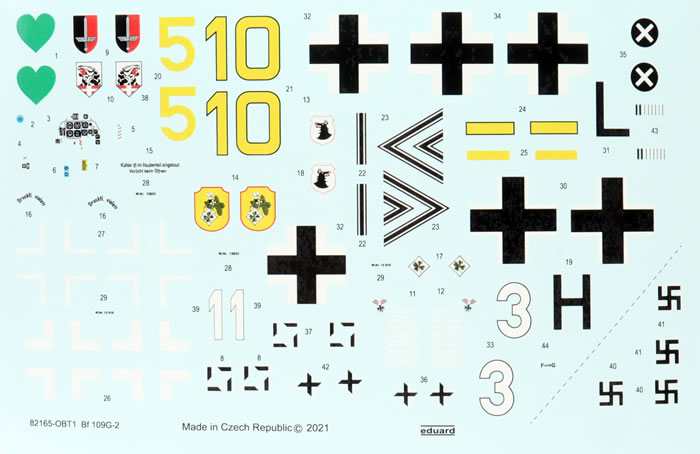
The two decal sheets are the current style produced by Eduard.
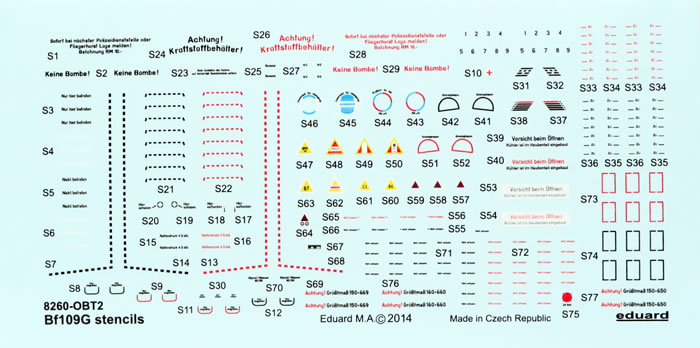
Printing and registration look good on my sample.
Eduard's 1/48 scale Messerschmitt Bf 109 G-2 is well detailed and boasts surface textures as good as anything currently available. The addition of coloured photo-etched parts plus a decal sheet with six varied options is always welcome.
I have built at least four of Eduard's 1/48 scale Bf 109 G kits and they have always been a joy to work on - straightforward engineering, brilliant fit and a gorgeous result once they're finished. I have no reason to expect that this kit will be any different.
Thanks to Eduard for the sample.
Review Text Copyright © 2024 by
Brett Green
Page Created 6 November, 2024
Last updated
6 November, 2024
Back to HyperScale Main Page
Back to Reviews Page |
